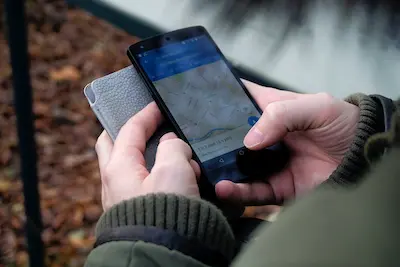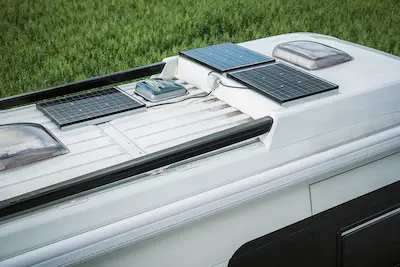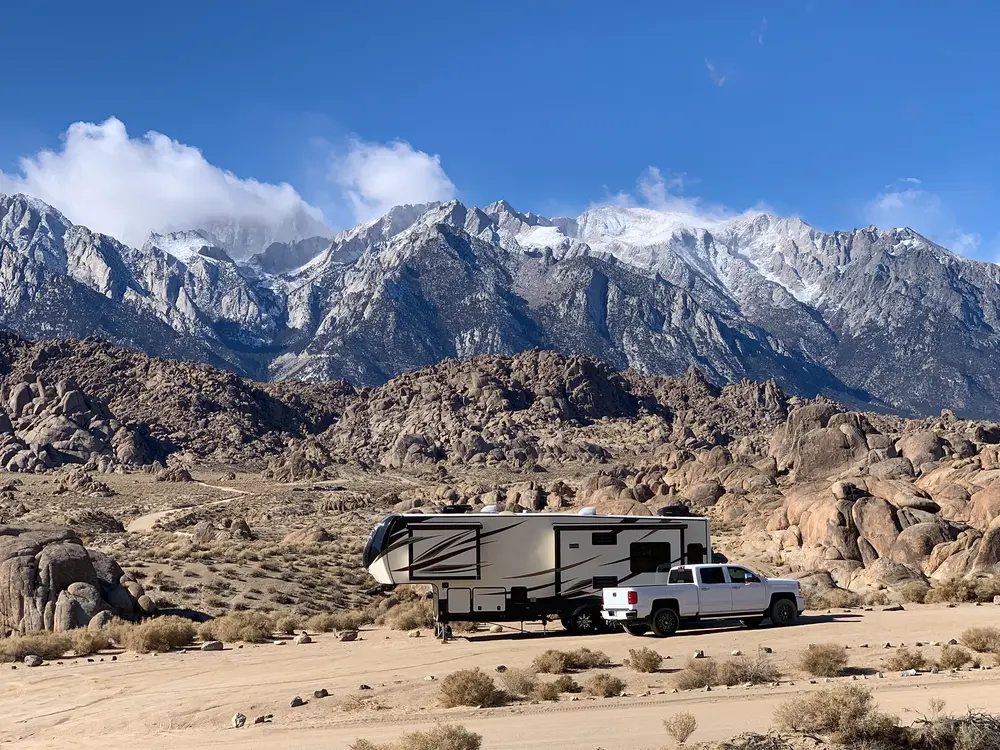Boondocking, also known as dry camping, is a popular way for RVers to escape the hustle and bustle of everyday life and experience the beauty of nature. Unlike traditional camping, boondocking involves camping without any hookups, meaning you’re not connected to any external water, electrical, or sewage systems.
This type of RVing offers you the opportunity to truly immerse yourself in your surroundings and get off the beaten path. You also save money by not having to pay campground or RV park fees.
Boondocking in the wilderness requires more preparation and planning than what is required when RVing at an RV park in a more populated and resourced area. When you’re boondocking, you’re entirely self-sufficient. This means you need to plan more carefully to make sure your RV is ready and you’ve brought all the essential items and food to make your trip a success.
Here are 5 things to do before you begin your boondocking trip:
1. Research Your Destination
2. Prepare Your RV
3. Plan Your Meals
4. Bring the Essential Gear
5. Prepare for an Emergency
1. Research Your Destination
Before setting out on your trip, go online and research the area you plan to boondock. Look for any regulations that may be in place, such as any permit requirements or restrictions on where you can park your RV. Look at the weather forecast to see what kind of rain, wind, low temperatures or high temperatures you may need to prepare for.
Using the satellite view of your Google Maps or Apple Maps app, get to know the terrain and surroundings of the area you’re planning to camp in, as well as what kind of road conditions you’ll have as you approach your boondocking location. Make note of the direction and distance to the nearest town or emergency services.
We recommend downloading and using a boondocking app such as iOverlander or Campendium to learn more about the area you’ll be visiting, and to read up on what fellow boondockers might be saying about it.
Estimate the drive time to your destination. Make sure you plan to start your trip early enough in the day to be able to get to your destination before sunset. You’ll want to be able to set up at your site while you still have light.

2. Prepare Your RV
Check and top off all engine fluids such as coolant, brake fluid, oil and window washer fluid. Check the pressure of each of your tires, including the spare tire.
Empty your grey and black water tanks, fill your fresh water tank, and fill your propane tank. If you plan to use a generator while boondocking, check the oil level of the generator and make sure you are bringing a sufficient amount of fuel.
Consider upgrading your RV with boondocking-specific equipment that can help you generate and store power you need when you are not connected to external power sources. Power equipment that is helpful when boondocking include:
- A portable generator, which supplies power when your batteries are running low
- Lithium batteries or AGM batteries, which provide more capacity than lead acid batteries
- Solar panels, which generate free power from the sun and reduce your reliance on a generator
- A battery monitor, which helps you keep track of your battery levels and avoid running out of power unexpectedly
- LED lights, which use less power than traditional incandescent bulbs and can help you reduce battery drain at night when the lights are on

3. Plan Your Meals
Before you head out for your boondocking trip, determine what you will be eating each day. Take some time to create a meal plan, and make a shopping list of all the ingredients you will need. This will help you stay organized and ensure that you have all the necessary ingredients on hand for the entire time you plan to be out.
When choosing meals for your trip, look for simple recipes that don’t require a lot of special ingredients and that are easy to prepare and store. A one-pot meal (such as soup, stew, or casserole) is easier to cook and can be reheated quickly, which will minimize excessive use of propane or power. Salads and sandwiches are easy to make and can be eaten cold.
When determining your meal schedule, plan to eat first the meals that use a lot of perishable food items (especially ones that will expire quickly). You can pack these food items in a cooler with ice packs, which helps expand your food storage space if you have a smaller RV refrigerator.

Use quality food storage containers to keep your meals fresh and organized. Choose containers that are stackable and easy to store in your cooler, RV’s fridge or freezer. If you want to cook some of your meals outside on a portable stove or camping grill while boondocking, make sure you have everything you need for that, such as grilling utensils and fuel.
Bring more food than you think you need, especially in case you decide to extend your stay an extra day or two. It’s always better to have too much than not enough.
Don’t forget to bring lots of drinking water. Even if you have a large freshwater tank onboard your RV, water will be used up more quickly than you’d think. Water jugs, such as this one, can easily be purchased to store water in an RV.
We recommend sizes between 3 and 5 gallons. The compact size of a 3 to 5-gallon water jug takes up minimal space, making it ideal for use in areas where storage space is limited. The jug’s handle and lighter weight make it easy to carry and transport additional water.
4. Bring the Essential Gear
When you’re boondocking in an RV, there’s no convenience store around the corner, so bringing essential items is absolutely crucial when you’re off the grid. From basic food preparation to creature comforts, having the right stuff with you can mean the difference between an enjoyable experience and a miserable one.
For the best boondocking experience, bring the following essential items:
- Leveling blocks – most boondocking locations tend to slope one way or another and require the use of leveling blocks to level your RV
- Home tool kit to be able to do repairs on the fly
- Paper maps – these will help you navigate and find your way to your destination in the likely chance you lose cell reception and can no longer rely on Apple Maps or Google Maps
- A propane stove and/or grill if you plan on cooking some of your meals outside – remember to buy enough portable propane cylinders
- Hand lighters – we recommend having several of these available, in case one runs out
- Solo Stove – these smokeless fire pits, which come in various sizes, are perfect for when you want to hang out around an outdoor fire
- Flashlights and headlamps
- Two-way radios, which can be useful for communicating with other members of your group or for getting help in an emergency
- Camping chairs and table, which will provide a comfortable place to relax and enjoy the outdoors
- A hammock
- Bug spray
- Biodegradable toilet paper, which will equip you to use the bathroom outside and therefore keep your blackwater tank from filling too quickly (you must bury your waste at least 6 to 8 inches deep and at least 200 feet from trails, water sources, and campsites)
- Large shower wipes to stay clean without having to use water for showering
If there’s a chance you might get some cell coverage in the area you’re boondocking, and you want to have internet or cell connection, you might want to consider buying a cell phone booster such as a WeBoost.
If you’ll be boondocking near a lake or river, consider also bringing the following items to be able to use the water from it:
- Portable water containers, which will allow you to easily transport and store water
- Water filtration system, to make sure the water you’re drinking and using is clean and safe
- Portable outside shower – using lake for river water for showering will allow you to use less water from your freshwater tank, and will keep your grey water tank from filling too quickly
- Biodegradable soap for washing hands, face, dishes, etc. (remember: even biodegradable soaps must be used at least 200 feet from a lake or river)
5. Prepare For An Emergency
Being away from civilization means you’re on your own when it comes to handling any kind of emergency. But there is no reason to be concerned. With preparation, you can handle anything that comes your way.
There are a few things to prepare for emergencies when boondocking in an RV.
- Get a good first aid kit. You never know what kind of injuries will occur while boondocking, so having a first aid kit is essential. A good kit will include bandages, antiseptic and painkillers. If you already have a first aid kit, check your kit before leaving to restock anything that’s expired or used up.
- Consider purchasing a satellite emergency communicator such as a Garmin InReach. When you’re far away from civilization, cell phone service can be spotty or nonexistent. Bringing a satellite communicator can be a saver in a life or death situation.
- Always have a fire extinguisher, which can be a lifesaver in case of a fire, in your RV. Place it in a location that is clearly visible and make sure everyone knows where it’s located.
- Check the weather forecast. Boondocking means being in the elements, so it’s helpful to stay aware of the weather forecast. Be prepared for extreme temperatures, storms, high winds, and other weather events. Bring extra clothing and gear to stay warm or cool as needed.
Conclusion
Boondocking is a wonderful way to experience nature and escape the stresses of everyday life. It’s important to be prepared and bring along the essential equipment, gear, food and water to ensure a safe and enjoyable trip. By taking the time to carefully plan and prepare for your boondocking adventure, you can enjoy all the benefits of this unique and rewarding experience.
Related Questions
How Can I Expand My Water Capacity When Boondocking?
Adding water jugs, utilizing potable water bladders or buying a truck holding tank are some of the ways you can increase your water carrying capacity. Read more about this in our article “How to Carry Extra Water in an RV – 5 Ways to Expand Capacity.”
How Can I Extend My Time Boondocking?
The best way to extend boondocking time is to expand your utility capacity and storage. Increasing your supply of power, water and propane as well as supplementing your black and grey tank capacity, will prolong your stay many days. By minimizing your usage of power, water, propane and sewer, you can lengthen your time boondocking even more. Read our article “How To Extend Your Time Boondocking In An RV”

